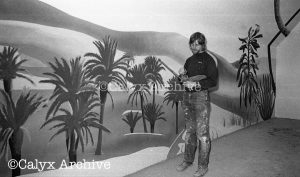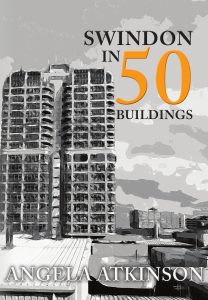January 2020
In Xanadu did Kubla Khan
Samuel Taylor Coleridge – Kubla Khan (1816)
A stately pleasure-dome decree:
Where Alph, the sacred river, ran
Through caverns measureless to ma
Down to a sunless sea.
For No 10 in my series on Swindon in 50 More Buildings we’re paying a visit to the Oasis Pleasure Dome. Have you got your towel under your arm?
Billed as a lagoondome, the early 1970s saw The Oasis mushroom out of the ashes of British Rail’s Shop 16.
As Barry Leighton wrote in the Swindon Advertiser in 2015:
‘In the glum, economically testing times of the early Seventies it seemed like a dream. A ray of extravagant, faraway sunshine that had contrived to pierce a doom-clouded era of strikes, the oil crisis and a three-day week to illuminate an unlikely corner of North Wiltshire.’ He goes on to describe how the bulbous, £170,000, see-through glazed centrepiece of the three-storey play Mecca came from the USA – was lauded as ‘the biggest leisure dome in Europe.’
Symbiotic relationship
All elements of the Oasis combined to meet the description of a fertile spot in a desert where you find water. The desert part being the urban sprawl in which it sits.
So, the much-loved dome let sunshine stream in and blue skies canopy bathers, giving them a sense of being outside. And all this decades before Center Parcs came our way.
Aside from the dome itself, what made the eponymous leisure pool so famous and so worthy of its name was the carefully planned, tropical themed interior – right down to real banana plants and the Ken White mural you see below, It all combined to create a totally tropical paradise experience.
The other factor making this pool special is its accessibility. The Oasis is not only the only leisure/fun pool for MILES – the nearest being Bracknell – it’s also the only fully accessible facility for children and those with mobility issues. Its lagoon shape, that you can simply walk into as you’d walk into the sea itself, is perfect for families and the less mobile. There is nothing else like it in Swindon – or for miles around.
Award winning
In 1976 the American National Swimming Pool Institute awarded the Oasis an Oscar of the swimming pool world. They bestowed a gold medal on it and hailed it as the world’s top residential pool of 1976! Wow!
What’s more, following the later addition of the domebuster water chutes (I burst my eardrum on those – never been right since) the Oasis became, for a while, Wiltshire’s biggest attraction! Yep – as Barry Leighton exclaimed: Bigger than Stonehenge!
Key Architectural Facts:
Structural System, space frame
Architect, F Gillinson Barnett & Partners
Year of construction, 1975
Those dry details to one side, it’s rumoured that one Noel Gallagher took inspiration from our Oasis for his … The story goes as follows:
Back in 1991, Noel Gallagher visited Swindon while working as a roadie for an indie band, Inspiral Carpets. Brother Liam, along for the gig, found himself drawn to the name Oasis as a new name for their band then called The Rain. Though not at once enamoured with the idea, Noel came round and Oasis they became. At length. Thus, as this piece from The Guardian states, Swindon’s Oasis pleasure dome earned a footnote in pop history – circa 1991.
The last of a typology
Architect Robert Guy tells how the Oasis is one of the last remaining leisure pools designed by Gillinson Barnet & Partners of Leeds. Further it’s the last remaining example of a leisure pool from the 70s- all others have been demolished or much changed.
*It also happens to be the best example that embodies the aims of the originators and is unique in its form.
Guy himself visited the Oasis in 1978 as an undergraduate. A visit that set him off on his own career in leisure architecture. He went on to design Coral Reef at Bracknell.
Mr Guy tells too of how the dome is a feature of the design and forerunner of buildings such as The Great Glass House at the National Botanical Garden of Wales in Carmarthenshire, Wales by Foster Associates. And that It also fits into a much larger context of historic domed buildings including the Leeds Corn Exchange, The Devonshire Dome, now at the University of Derby at Buxton and the Royal Albert Hall.
Read Robert’s article for the Architect’s Journal about the Oasis here: ‘Loss of a typology’: campaigners call for listing of Swindon leisure centre
* If this building is not retained then the whole building type will have disappeared. Demolishing the Oasis will be akin to killing the last butterfly.
Okay – so that’s a bit of exaggeration. But it WILL be cultural vandalism.
Seen on Instagram – The Wiltopian – https://www.instagram.com/wiltopian/
‘ …. The Oasis is the most innovative of 20th-century public structures offered in the town AND county. The dome part of the building was the 3rd of its kind built in the UK and at the time was the largest dome in Europe.
The design screams the influence of Pierre Luigi Nervi’s iconic Palazzetto Dello Sport.
Related: https://swindonian.me/2019/06/03/the-nervi-football-stand-that-swindon-almost-got/
Regardless of architectural significance, the leisure centre’s cultural significance is big.
It represents everything about this period in Britain, at a time when Swindon was a key player in providing overspill space for London. These new-town communities were attractive prospects for new families. In 1974, the build of the Oasis was slap-bang between the 50s/ 60s expansion to the east of the town and the 70s/80s expansion to the west.
The Oasis provided exciting leisure facilities for a rapidly growing audience made up of families, where many enjoyed a tropical paradise within an industrial urban town … ‘
Somewhat related to all that is this piece on the blog:
Iconic Swindon
For sure it’s an iconic building and one that I wanted to put into Swindon in 50 Buildings but couldn’t find the room for it. Thus it had an assured place in this blog series. It’s second only to the David Murray John Tower as saying ‘Swindon’.
Like so many buildings in Swindon a Ken White mural of a desert theme once graced it. That ended up being painted over when tanking works to protect the concrete from humidity took place.

We Are Swindon
The Twentieth Century Society
The Twentieth Century Society describe the Oasis thus here: https://c20society.org.uk/news/top-10-c20-society-buildings-at-risk-list-2021
‘ … It is the last major work of architectural partnership of Gillinson Barnett and Partners (GBP), where Peter Sargent and Clifford Barnett were senior partners, the pre-eminent designers of leisure centres during this period.
At Swindon a large free form pool was enclosed by a 45-metre dome (the largest of its type in Europe) composed of an aluminium frame with transparent PVC panels.
The RIBA Guides to Modern Architecture described it as a ‘fantasy structure, its half-submerged dome resembling a flying-saucer.’
The Oasis is separated into a ‘wet side’, containing leisure pools and extensive waterslides, and ‘dry side’ for sports and recreation activities, the two being connected by the changing rooms, entrance hall and restaurant.’
See also: https://swindonian.me/category/the-oasis/









